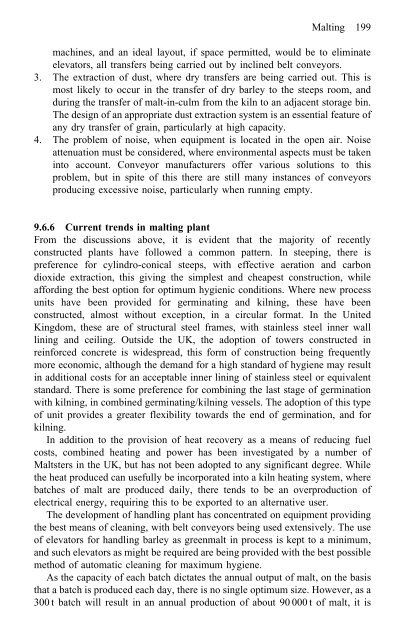Cereals processing technology
Cereals processing technology
Cereals processing technology
Create successful ePaper yourself
Turn your PDF publications into a flip-book with our unique Google optimized e-Paper software.
Malting 199<br />
machines, and an ideal layout, if space permitted, would be to eliminate<br />
elevators, all transfers being carried out by inclined belt conveyors.<br />
3. The extraction of dust, where dry transfers are being carried out. This is<br />
most likely to occur in the transfer of dry barley to the steeps room, and<br />
during the transfer of malt-in-culm from the kiln to an adjacent storage bin.<br />
The design of an appropriate dust extraction system is an essential feature of<br />
any dry transfer of grain, particularly at high capacity.<br />
4. The problem of noise, when equipment is located in the open air. Noise<br />
attenuation must be considered, where environmental aspects must be taken<br />
into account. Conveyor manufacturers offer various solutions to this<br />
problem, but in spite of this there are still many instances of conveyors<br />
producing excessive noise, particularly when running empty.<br />
9.6.6 Current trends in malting plant<br />
From the discussions above, it is evident that the majority of recently<br />
constructed plants have followed a common pattern. In steeping, there is<br />
preference for cylindro-conical steeps, with effective aeration and carbon<br />
dioxide extraction, this giving the simplest and cheapest construction, while<br />
affording the best option for optimum hygienic conditions. Where new process<br />
units have been provided for germinating and kilning, these have been<br />
constructed, almost without exception, in a circular format. In the United<br />
Kingdom, these are of structural steel frames, with stainless steel inner wall<br />
lining and ceiling. Outside the UK, the adoption of towers constructed in<br />
reinforced concrete is widespread, this form of construction being frequently<br />
more economic, although the demand for a high standard of hygiene may result<br />
in additional costs for an acceptable inner lining of stainless steel or equivalent<br />
standard. There is some preference for combining the last stage of germination<br />
with kilning, in combined germinating/kilning vessels. The adoption of this type<br />
of unit provides a greater flexibility towards the end of germination, and for<br />
kilning.<br />
In addition to the provision of heat recovery as a means of reducing fuel<br />
costs, combined heating and power has been investigated by a number of<br />
Maltsters in the UK, but has not been adopted to any significant degree. While<br />
the heat produced can usefully be incorporated into a kiln heating system, where<br />
batches of malt are produced daily, there tends to be an overproduction of<br />
electrical energy, requiring this to be exported to an alternative user.<br />
The development of handling plant has concentrated on equipment providing<br />
the best means of cleaning, with belt conveyors being used extensively. The use<br />
of elevators for handling barley as greenmalt in process is kept to a minimum,<br />
and such elevators as might be required are being provided with the best possible<br />
method of automatic cleaning for maximum hygiene.<br />
As the capacity of each batch dictates the annual output of malt, on the basis<br />
that a batch is produced each day, there is no single optimum size. However, as a<br />
300 t batch will result in an annual production of about 90 000 t of malt, it is



